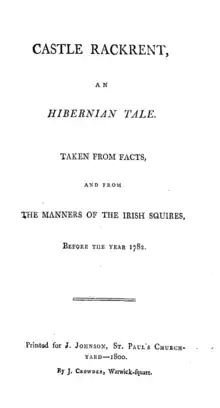Castle Rackrent
Castle Rackrent is a short novel by Maria Edgeworth published in 1800. Unlike many of her other novels, which were heavily "edited" by her father before their publication, the published version is close to her original intention.
 Title page of the first edition. | |
| Author | Maria Edgeworth |
|---|---|
| Country | Ireland |
| Language | English |
| Genre | Historical novel |
| Publisher | J. Johnson |
Publication date | 1800 |
| Media type | Print (Hardback & Paperback) |
| Pages | 90 |
Shortly before its publication, an introduction, glossary and footnotes, written in the voice of an English narrator, were added to the original text to blunt the negative impact the Edgeworths feared the book might have on English enthusiasm for the Act of Union 1800.[1]
Plot summary
The novel is set prior to the Constitution of 1782. It tells the story of four generations of Rackrent heirs through their steward, Thady Quirk. The heirs are: the dissipated spendthrift Sir Patrick O'Shaughlin, the litigious Sir Murtagh Rackrent, the cruel husband and gambling absentee Sir Kit Rackrent, and the generous but improvident Sir Condy Rackrent. Their sequential mismanagement of the estate is resolved through the machinations—and to the benefit—of the narrator's astute son, Jason Quirk.
Themes and style
Kathryn Kirkpatrick suggests that the novel "both borrows from and originates a variety of literary genres and subgenres without neatly fitting into any one of them".[2] It satirises Anglo-Irish landlords and their overall mismanagement of the estates they owned at a time when the English and Irish parliaments were working towards formalising their union through the Acts of Union. Through this and other works, Edgeworth is credited with serving the political, national interests of Ireland and the United Kingdom the way Sir Walter Scott did for Scotland.[3]
Castle Rackrent is a dialogic novel, comprising a preface and conclusion by an editor bookending a first person narrative proper. It is widely regarded as the first British novel to use the device of a narrator who is both unreliable and an observer of, rather than a player in, the actions he chronicles. It also has a glossary (which was a last-minute addition).[2]
Importance
Castle Rackrent is sometimes regarded as the first historical novel, the first regional novel in English, the first Anglo-Irish novel, the first Big House novel and the first saga novel.[2] William Butler Yeats pronounced Castle Rackrent "one of the most inspired chronicles written in English".[4][5]
The novel is alluded to in The Great Gatsby by F. Scott Fitzgerald.
References
- Twomey, Ryan. (2014). Preface to Castle Rackrent. New York, Norton Critical Edition. ISBN 978-0-393-92241-7.
- Kirkpatrick, Kathryn J. (1995) "Introduction to Castle Rackrent", Oxford, Oxford University Press
- Todd, Janet (2006) The Cambridge introduction to Jane Austen, Cambridge, Cambridge University Press
- W. B. Yeats, Representative Irish Tales (1891; Atlantic Highlands, NJ, 1979), 27.
- Kirkpatrick, Kathryn J. (1995). Introduction to Castle Rackrent. Oxford University Press. ISBN 978-0-19-953755-6.
External links
| Wikisource has original text related to this article: |
- Castle Rackrent at Project Gutenberg
 Castle Rackrent public domain audiobook at LibriVox
Castle Rackrent public domain audiobook at LibriVox
